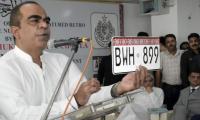Do you know someone who’s died in a car crash? If you live in the United States, the odds say you probably do. We’ve been averaging over 40,000 deaths a year for the past half-century.
The United States, of course, hardly rates as the only nation with ongoing highway carnage. Traffic deaths remain a problem all across the world. Car accidents globally are claiming 1.3 million lives a year, with 50 million additional people suffering serious injuries.
But these huge numbers obscure an equally troubling ongoing reality: The rates of auto deaths vary enormously by nation. Some societies are making remarkable progress on the traffic-death front. In Norway, for instance, the city of Oslo saw 41 auto-related deaths in 1975, only one last year.
The United States has also registered some progress on highway death rates, but not nearly as much as Norway and other nations. U.S. road fatalities, one 2018 study found, have fallen 23 percent over recent years. But our peer developed nations in Europe and elsewhere have dropped their death rates from between 26 and 64 percent over the same time span. The United States now has a higher per-capita road fatality rate than any other major developed nation.
“If the US had the same crash death rate as Sweden,” notes one recent analysis, “about 24,000 fewer lives per year would be lost.”
Worse yet, current US officials responsible for keeping our roads as safe as possible don’t particularly seem to care about stats like these. Last month, at a global road safety conference in Sweden that drew government ministers and experts from over 140 nations, only one nation refused to endorse the declaration that emerged out of the conference deliberations. That nation: the United States.
The landmark “Stockholm Declaration” that the US delegation chose to reject describes “the overwhelming majority of road traffic deaths” as “preventable” and “a major development and public health problem that has broad social and economic consequences.”
The world’s nations, the Stockholm Declaration continues, should all “contribute to reducing road traffic deaths by at least 50 percent from 2020 to 2030.”
Why did the United States take exception? The US delegation found it “necessary to dissociate ourselves from certain paragraphs” in the Declaration that “muddle our focus.” Issues like “climate change, gender equality, reduced inequalities, responsible consumption and production,” the delegation pronounced, do “not directly” relate to road safety.
Sweden’s King Carl XVI Gustaf pronounced just the opposite when he opened the Stockholm gathering. The conference, he noted, represented “an “opportunity to link the road safety challenge to other sustainability challenges, such as climate change, health, equality, poverty and human rights.”
The delegates who gathered in Stockholm had plenty of reason to explore all those links, especially on equality. The nations with the lowest auto death rates just happen to be among the world’s nations with the smallest gaps between the wealthy and everyone else. Among major developed nations, the United States has both the highest traffic death rates and the most economic inequality. Just coincidence? Or could maldistributions of income and wealth be contributing somehow to traffic tragedy?
Epidemiologists – the scientists who study the health of populations – have already linked societal death rates overall to inequality. People in more unequal nations, their research shows, live longer, healthier lives than people in more unequal nations.
Could the same dynamics be at play with traffic deaths? Could inequality impact what happens when people get behind steering wheels? Inequality most definitely could – and does.
Let’s start with the roads that stretch underneath our tires. These roads, if poorly maintained, can become hazards to our health. And roads across the United States have been poorly maintained – in no small part because America’s wealthy have been bankrolling tax-cut campaigns to keep their own taxes as low as they can get them. The richer America’s rich have become, the greater their interest in keeping taxes low and their greater their bankrolling capacity.
The tax-cuts the campaign contributions of the wealthy proliferate have starved state and local governments of the funding they need to adequately maintain our highways. The inevitable result? Highways get slick when rains come. Potholes have cars suddenly swerving. Faded traffic lane lines create driver confusion. The roads become more dangerous and driving more stressful.
Add to that stress the added daily tension of life in economically stratified social settings. Inequality, for instance, lengthens commuting times as average Americans have to locate themselves ever farther away from their jobs to find affordable housing. All this stress and tension ends up exploding into road rage, into the sorts of driving behaviors that make deadly traffic accidents much more likely.
But inequality doesn’t just nurture road rage. Research psychologists have also begun focusing attention on what we might call the “road arrogance” of the rich.
One new study, funded by the federal National Institutes of Health, has found drivers of expensive cars “less likely to stop for people on foot trying to cross the street.”
Drivers prone to “speeding, tailgating, passing without signaling, and generally driving aggressively tend to be men and tend to drive high-status cars,” adds the lead author of another recent study that appears in the Journal of International Psychiatry.
Both these studies build on research from psychologist Paul Piff that positively associates “higher social-class standing” with “increased feelings of entitlement and narcissism.”
Road rage. Road arrogance. Road disrepair. One other impact of inequality seems relevant here, what economist Robert Reich has dubbed the “secession of the successful.” Simply put, this thesis holds that the affluent, as levels of inequality increase, disengage from the rest of society. They live in their own separate world and don’t particularly fret about what’s happening outside their own social universe.
The most disengaged of all – our super rich – also have the most political power. They determine, to an exceptionally high degree, which problems get seriously addressed and which problems languish and fester. For our super rich, traffic safety simply doesn’t rate as a major concern.
Excerpted from: ‘Why Do Cars Kill More People in Unequal Nations?’.
Courtesy: Counterpunch.org
One might ask why such special benches are necessary in first place, but let’s shelve that question for now
Arbitration as a means to resolve a dispute between parties has gained global traction for many decades
One may pick up any avenue of national life to realise that it has either stopped functioning altogether or is...
On January 18, Dr Ayub Sheikh gathered admirers of Ghulam Hussain Rangrez, an author of many books in Sindhi
People in Pakistan are worried about what return of Donald Trump to White House has meant for Pakistan
Pakistan holds immense potential for leveraging AI in education, with localised examples already showing promise







